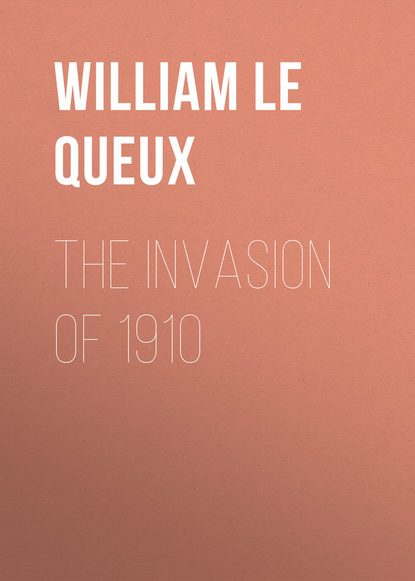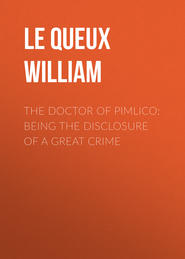По всем вопросам обращайтесь на: info@litportal.ru
(©) 2003-2024.
✖
The Invasion of 1910
Настройки чтения
Размер шрифта
Высота строк
Поля
If South London was in such a state of starvation, even though small quantities of food were daily coming in, Von Kronhelm’s position must have been one of extreme gravity when it is remembered that his food supply was now cut off. It was calculated that each of his five army corps operating upon London consumed in the space of twenty-four hours 18,000 loaves weighing 3 lb. each, 120 cwt. of rice or pearl barley, seventy oxen or 120 cwt. of bacon, 18 cwt. of salt, 30 cwt. of coffee, 12 cwt. of oats, 3 cwt. of hay, 3500 quarts of spirits and beer, with 60 cwt. of tobacco, 1,100,000 ordinary cigars, and 50,000 officers’ cigars for every ten days.
And yet all was provided for at Southminster, Grimsby, King’s Lynn, Norwich, and Goole. Huge food bases had been rapidly established from the first day of the invasion. The German Army, whatever might be said of it, was a splendid military machine, and we had been in every way incapable of coping with it. Yet it was impossible not to admire the courage and patriotism of the men under Byfield, Hibbard, and Woolmer in making the attempt, though from the first the game had been known to be hopeless.
West of London the members of the Hendon and other rifle clubs, together with a big body of Frontiersmen and other free-shooters, were continually harassing the Saxon advanced posts between Shepperton and Colnbrook, towards Uxbridge. On the 24th a body of 1,500 riflemen and Frontiersmen attacked a company of Saxon Pioneers close to where the Great Western Railway crosses the River Crane, north of Cranford. The Germans, being outnumbered, were obliged to withdraw to Hayes with a loss of twenty killed and a large force of wounded. Shortly afterwards, on the following day, the Pioneers, having been reinforced, retraced their steps in order to clear the districts on the Crane of our irregular forces; and they announced that if, as reported, the people of Cranford and Southall had taken part in the attack, both places would be burned.
That same night the railway bridges over the Crane and the Grand Junction Canal in the vicinity were blown up by the Frontiersmen. The fifty Saxons guarding each bridge were surprised by the British sharpshooters, and numbers of them shot. Three hours later, however, Cranford, Southall, and Hayes were burned with petrol, and it was stated by Colonel Meyer, of the Saxons, that this was to be the punishment of any place where railways were destroyed. Such was the system of terrorism by which the enemy hoped to terminate the struggle. Such proceedings – and this was but one of a dozen others in various outlying spots beyond the Metropolitan area – did not produce the effect of shortening the duration of hostilities. On the contrary, they only served to prolong the deadly contest by exciting a wild desire for revenge in many who might otherwise have been disposed towards an amicable settlement.
With the dawn of the 25th September, a grey day with fine drizzling rain in London, the situation seemed still more hopeless. The rain, however, did not by any means damp the ardour of the defenders at the bridges. They sang patriotic songs, while barrel-organs and bands played about them night and day. Though hungry, their spirits never flagged. The newspapers printed across the river were brought over in small boats from the Surrey side, and eagerly seized and read by anxious thousands. The lists of British casualties were being published, and the populace were one and all anxious for news of missing friends.
The chief item of news that morning, however, was a telegram from the Emperor William, in which he acknowledged the signal services rendered by Field-Marshal Von Kronhelm and his army. He had sent one hundred and fifty Orders of the Iron Cross for distribution among officers who had distinguished themselves, accompanied by the following telegraphic despatch, which every paper in London was ordered to print: —
THE KAISER’S TELEGRAM
Potsdam, Sept. 21st, 1910.
GENERAL VON KRONHELM, – Your heroic march, your gallant struggle to reach London, your victorious attack and your capture of the Capital of the British Empire, is one of the greatest feats of arms in all history.
I express my royal thanks, my deepest acknowledgments, and bestow upon you the Grand Cross of the Red Eagle, with the sword, as proof of this acknowledgment.
Your grateful Emperor,
WILHELM.
THE TELEGRAM SENT BY THE GERMAN EMPEROR TO
FIELD-MARSHAL VON KRONHELM
The wharves and embankments of the Surrey shore of the Thames, from Erith to Kingston, were being patrolled day and night by armed men. Any boat crossing the river was at once challenged, and not allowed to approach unless under a flag of truce, or it was ascertained that its occupants were non-belligerents. Everywhere the greatest precaution was being taken against spies, and on the two or three occasions when the Germans had reconnoitered by means of balloons, sharpshooters had constantly fired at them.
As may well be imagined, spy-mania was now rife in every quarter in South London, and any man bearing a foreign name, no matter of what nationality, or known to be a foreigner, was at once suspected, and often openly insulted, even though he might be a naturalised Englishman. It was very unsafe for any foreigner now to go abroad. One deplorable incident occurred that afternoon. A German baker, occupying a shop in Newington Butts, and who had lived in England twenty-five years and become a naturalised British subject, was walking along the Kennington Road with his wife, having come forth in curiosity to see what was in progress, when he was met by a man with whom he had had some business quarrel. The man in question, as he passed, cried out to the crowd that he was a German. “He’s one of Von Kronhelm’s spies!” he shouted.
At the word “spy” the crowd all turned. They saw the unfortunate man had turned pale at this charge, which was tantamount to a sentence of death, and believed him to be guilty. Some wild and irrepressible men set up a loud cry of “Spy! Spy! Down with him! Down with the traitor!” and ere the unfortunate baker was aware of it he was seized by a hundred hands, and lynched.
More than once real spies were discovered, and short shrift was meted out to them; but in several instances it is feared that gross mistakes were made, and men accused as spies out of venomous personal spite. There is little doubt that under cover of night a number of Von Kronhelm’s English-speaking agents were able to cross the river in boats and return on the following night, for it was apparent by the tone of the newspapers that the German generalissimo was fully aware of what was in progress south of the river.
To keep a perfect watch upon a river-front of so many miles against watermen who knew every landing-place and every point of concealment, was utterly impossible. The defenders, brave men all, did their best, and they killed at sight every spy they captured; but it was certain that the enemy had established a pretty complete system of intelligence from the camp of the defiant Londoners.
At the barricades was a quiet, calm enthusiasm. Now that it was seen that the enemy had no immediate intention of storming the defences at the bridges, those manning them rested, smoked, and, though ever vigilant, discussed the situation. Beneath every bridge men of the Royal Engineers had effected certain works which placed them in readiness for instant destruction. The explosives were there, and only by the pressing of the button the officer in command of any bridge could blow it into the air, or render it unsafe for the enemy to venture upon.
The great League of Defenders was in course of rapid formation. Its proclamations were upon every wall. When the time was ripe, London would rise. The day of revenge was fast approaching.
London, north of the Thames, though shattered and wrecked, began, by slow degrees, to grow more calm.
One half of the populace seemed to have accepted the inevitable; the other half being still terrified and appalled at the havoc wrought on every hand. In the case of Paris, forty years before, when the Germans had bombarded the city, their shells had done but little damage. In those days neither guns nor ammunition were at such perfection as they now were, the enemy’s high-power explosives accounting for the fearful destruction caused.
A very curious fact about the bombardment must here be noted. Londoners, though terrified beyond measure when the shells began to fall among them and explode, grew, in the space of a couple of hours, to be quite callous, and seemed to regard the cannonade in the light of a pyrotechnical display. They climbed to every point of vantage, and regarded the continuous flashes and explosions with the same open-mouthed wonder as they would exhibit at the Crystal Palace on a firework night.
The City proper was still held by the Xth Corps under General von Wilburg, who had placed a strong cordon around it, no unauthorised person being allowed to enter or leave. In some of the main roads in Islington, Hoxton, Whitechapel, Clapton, and Kingsland, a few shops that had not been seized by the Germans had courageously opened their doors. Provision shops, bakers, greengrocers, dairies, and butchers were, however, for the most part closed, for in the Central Markets there was neither meat nor vegetables, every ounce of food having been commandeered by German foraging parties.
As far as possible, however, the enemy were, with the aid of the English Advisory Board, endeavouring to calm the popular excitement and encourage trade in other branches. At certain points such as at Aldgate, at Oxford Circus, at Hyde Park Corner, in Vincent Square, Westminster, at St. James’s Park near Queen Anne’s Gate, and in front of Hackney Church, the German soldiers distributed soup once a day to all comers, Von Kronhelm being careful to pretend a parental regard for the metropolis he had occupied.
The population north of the Thames was not, however, more than one quarter what it usually was, for most of the inhabitants had fled across the bridges during the bombardment, and there remained on the Surrey side in defiance of the invader.
Night and day the barricade-builders were working at the bridges in order to make each defence a veritable redoubt. They did not intend that the disasters of the northern suburbs – where the bullets had cut through the overturned carts and household furniture as through butter – should be repeated. Therefore at each bridge, behind the first hastily-constructed defence, there were being thrown up huge walls of sacks filled with earth, and in some places where more earth was obtainable earthworks themselves with embrasures. Waterloo, Blackfriars, Southwark, London, and Cannon Street bridges were all defended by enormous earthworks, and by explosives already placed for instant use if necessary. Hungerford Bridge had, of course, been destroyed by the Germans themselves, huge iron girders having fallen into the river; but Vauxhall, Lambeth, Battersea, Hammersmith, and Kew and other bridges were equally strongly defended as those nearer the centre of London. Many other barricades had been constructed at various points in South London, such as across the Bridge End Road, Wandsworth, several across the converging roads at St. George’s Circus, and again at the Elephant and Castle, in Bankside, in Tooley Street, where it joins Bermondsey Street, at the approach to the Tower Bridge, in Waterloo Road at its junction with Lower Marsh, across the Westminster Bridge and Kennington Roads, across the Lambeth Road where it joins the Kennington Road, at the junction of Upper Kennington Lane with Harleyford Road, in Victoria Road at the approach to Chelsea Bridge, and in a hundred other smaller thoroughfares. Most of these barricades were being built for the protection of certain districts rather than for the general strategic defence of South London. In fact, most of the larger open spaces were barricaded, and points of entrance carefully blocked. In some places exposed barricades were connected with one another by a covered way, the neighbouring houses being crenellated and their windows protected with coal sacks filled with earth. Cannon now being brought in by Artillery from the south were being mounted everywhere, and as each hour went by the position of South London became strengthened by both men and guns.
CHAPTER XI
DEFENCES OF SOUTH LONDON
Preparations were being continued night and day to place the working-class districts in Southwark and Lambeth in a state of strong defence, and the constant meetings convened in public halls and chapels by the newly-formed League of Defenders incited the people to their work. Everybody lent a willing hand, rich and poor alike. People who had hitherto lived in comfort in Regent’s Park, Hampstead, or one or other of the better-class northern suburbs, now found themselves herded among all sorts and conditions of men and women, and living as best they could in those dull, drab streets of Lambeth, Walworth, Battersea, and Kennington. It was, indeed, a strange experience for them. In the sudden flight from the north parents had become separated from their children and husbands from their wives, so that in many cases haggard and forlorn mothers were in frantic search of their little ones, fearing that they might have already died of starvation or been trampled under foot by the panic-stricken multitudes. The dense population of South London had already been trebled. They were penned in by the barricades in many instances, for each district seemed to be now placing itself in a state of defence, independent of any other.
Kennington, for instance, was practically surrounded by barricades, tons upon tons of earth being dug from the “Oval” and the “Park.” Besides the barricades in Harleyford Road and Kennington Lane, all the streets converging on the “Oval” were blocked up, a huge defence arm just being completed across the junction of Kennington and Kennington Park roads, and all the streets running into the latter thoroughfare from that point to the big obstruction at the “Elephant” were blocked by paving stones, bags of sand, barrels of cement, bricks, and such-like odds and ends impervious to bullets. In addition to this, there was a double fortification in Lambeth Road – a veritable redoubt – as well as the barricade at Lambeth Bridge, while all the roads leading from Kennington into the Lambeth Road, such as St. George’s Road, Kennington Road, High Street, and the rest, had been rendered impassable and the neighbouring houses placed in a state of defence. Thus the whole district of Kennington became therefore a fortress in itself.
This was only a typical instance of the scientific methods of defence now resorted to. Mistakes made in North London were not now repeated. Day and night every able-bodied man, and woman too, worked on with increasing zeal and patriotism. The defences in Haverstock Hill, Holloway Road, and Edgware Road, which had been composed of overturned tramcars, motor ’buses, household furniture, etc., had been riddled by the enemy’s bullets. The lesson had been heeded, and now earth, sand, tiles, paving stones, and bricks were very largely used.
From nearly all the principal thoroughfares south of the river, the paving-stones were being rapidly torn up by great gangs of men, and whenever the artillery brought up a fresh Maxim or field-gun the wildest demonstrations were made. The clergy held special services in churches and chapels, and prayer-meetings for the emancipation of London were held twice daily in the Metropolitan Tabernacle at Newington. In Kennington Park, Camberwell Green, the Oval, Vauxhall Park, Lambeth Palace Gardens, Camberwell Park, Peckham Rye, and Southwark Park a division of Lord Byfield’s army was encamped. They held the Waterloo terminus of the South-Western Railway strongly, the Chatham Railway from the Borough Road Station – now the terminus – the South-Eastern from Bricklayers’ Arms, which had been converted into another terminus, as well as the Brighton line, both at Battersea Park and York Road.
The lines destroyed by the enemy’s spies in the early moments of the invasion had long ago been repaired, and up to the present railway and telegraphic communication south and west remained uninterrupted. The Daily Mail had managed to transfer some of its staff to the offices of a certain printer’s in Southwark, and there, under difficulties, published several editions daily despite the German censorship. While northern London was without any news except that supplied from German sources, South London was still open to the world, the cables from the south coast being, as yet, in the hands of the British, and the telegraphs intact to Bristol and to all places in the West.
Thus, during those stifling and exciting days following the occupation, while London was preparing for its great uprising, the South London Daily Mirror, though a queer, unusual-looking sheet, still continued to appear, and was read with avidity by the gallant men at the barricades.
Contrary to expectation, Von Kronhelm was leaving South London severely alone. He was, no doubt, wise. Full well he knew that his men, once within those narrow, tortuous streets beyond the river, would have no opportunity to manœuvre, and would, as in the case of the assault of Waterloo Bridge, be slaughtered to a man. His spies reported that each hour that passed rendered the populace the stronger, yet he did nothing, devoting his whole time, energy, and attention to matters in that half of London he was now occupying.
Everywhere the walls of South London were placarded with manifestoes of the League of Defenders. Day after day fresh posters appeared, urging patience and courage, and reporting upon the progress of the League. The name of Graham was now upon everyone’s lips. He had, it seemed, arisen as saviour of our beloved country. Every word of his inspired enthusiasm, and this was well illustrated at the mass meeting on Peckham Rye, when, beneath the huge flag of St. George, the white banner with the red cross, – the ancient standard of England, – which the League had adopted as theirs, he made a brilliant and impassioned appeal to every Londoner and every Englishman.
Report had it that the Germans had set a price upon his head, and that he was pursued everywhere by German spies – mercenaries who would kill him in secret if they could. Therefore he was compelled to go about with an armed police guard, who arrested any suspected person in his vicinity. The Government, who had at first laughed Graham’s enthusiasm to scorn, now believed in him. Even Lord Byfield, after a long council, declared that his efforts to inspire enthusiasm had been amazingly successful, and it was now well known that the “Defenders” and the Army had agreed to act in unison towards one common end – the emancipation of England from the German thraldom.
Some men of the Osnabrück Regiment, holding Canning Town and Limehouse, managed one night, by strategy, to force their way through the Blackwall Tunnel and break down its defence on the Surrey side in an attempt to blow up the South Metropolitan Gas Works close by.
The men holding the tunnel were completely overwhelmed by the numbers that pressed on, and were compelled to fall back, twenty of their number being killed. The assault was a victorious one, and it was seen that the enemy were pouring out, when, of a sudden, there was a dull, heavy roar, followed by wild shouts and terrified screams, as there rose from the centre of the river a great column of water, and next instant the tunnel was flooded, hundreds of the enemy being drowned like rats in a hole.
The men of the Royal Engineers had, on the very day previous, made preparations for destroying the tunnel if necessary, and had done so ere the Germans were aware of their intention. The exact loss of life is unknown, but it is estimated that over 400 men must have perished in that single instant, while those who had made the sudden dash towards the Gas Works were all taken prisoners, and their explosives confiscated.
The evident intention of the enemy being thus seen, General Sir Francis Bamford from his headquarters at the Crystal Palace gave orders for the tunnels at Rotherhithe and that across Greenwich Reach, as well as the several “tube” tunnels and subways, to be destroyed, a work which was executed without delay, and was witnessed by thousands, who watched for the great disturbances and upheavals in the bed of the river.
In the Old Kent Road the bridge over the canal, as well as the bridges in Wells Street, Sumner Road, Glengall Road, and Canterbury Road, were all prepared for demolition in case of necessity, the canal from the Camberwell Road to the Surrey Docks forming a moat behind which the defenders might, if necessary, retire. Clapham Common and Brockwell Park were covered with tents, for General Bamford’s force, consisting mostly of auxiliaries, were daily awaiting reinforcements.
Lord Byfield, now at Windsor, was in constant communication by wireless telegraphy with the London headquarters at the Crystal Palace, as well as with Hibbard on the Malvern Hills and Woolmer at Shrewsbury. To General Bamford at Sydenham came constant news of the rapid spread of the national movement of defiance, and Lord Byfield, as was afterwards known, urged the London commander to remain patient, and invite no attack until the League were strong enough to act upon the offensive.
Affairs of outposts were, of course, constantly recurring along the river bank between Windsor and Egham, and the British free-shooters and Frontiersmen were ever harassing the Saxons.
Very soon Von Kronhelm became aware of Lord Byfield’s intentions, but his weakness was apparent when he made no counter-move. The fact was that the various great cities he now held required all his attention and all his troops. From Manchester, from Birmingham, from Leeds, Bradford, Sheffield, and Hull came similar replies. Any withdrawal of troops from either city would be the signal for a general rising of the inhabitants. Therefore, having gained possession, he could only now sit tight and watch.
From all over Middlesex, and more especially from the London area, came sensational reports of the drastic measures adopted by the Germans to repress any sign of revolt. In secret, the agents of the League of Defenders were at work going from house to house, enrolling men, arranging for secret meeting-places, and explaining in confidence the programme as put forward by the Bristol committee. Now and then, however, these agents were betrayed, and their betrayal was in every case followed by a court-martial at Bow Street, death outside in the yard of the police station, and the publication in the papers of their names, their offence, and the hour of the execution.
Yet, undaunted and defiantly, the giant organisation grew as no other society had ever grown, and its agents and members quickly developed into fearless patriots. It being reported that the Saxons were facing Lord Byfield with the Thames between them, the people of West London began in frantic haste to construct barricades. The building of obstructions had, indeed, now become a mania north of the river as well as the south. The people, fearing that there was to be more fighting in the streets of London, began to build huge defences all across West London. The chief were across King Street, Hammersmith, where it joins Goldhawk Road, across the junction of Goldhawk and Uxbridge Roads, in Harrow Road where it joins Admiral Road, and Willesden Lane, close to the Paddington Cemetery, and the Latimer Road opposite St. Quintin Park Station. All the side streets leading into the Goldhawk Road, Latimer Road, and Ladbroke Grove Road, were also blocked up, and hundreds of houses placed in a state of strong defence.
With all this Von Kronhelm did not interfere. The building of such obstructions acted as a safety-valve to the excited populace, therefore he rather encouraged than discountenanced it. The barricades might, he thought, be of service to his army if Lord Byfield really risked an attack upon London from that direction.











